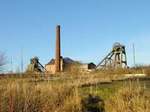

Section under construction
There is some confusion in more recent sources regarding the original ownership of Pleasley Colliery. Contemporary records show, however, that the colliery was owned by the Stanton Iron Company, later incorporated as the Stanton Ironworks Company Ltd. The confusion is not entirely helped, however, by the rather complex early background of the Stanton Ironworks Company and the various people involved at the outset.
There are two parts to the picture:
- the ownership and leasing of the land and mineral rights
- the ownership and operation of the colliery
The mineral rights aspect seems to be as follows:
- The lord of the manor of Pleasley was W.E. Nightingale (nee Shore). He had inherited the Nightingale estate from his great uncle Peter who died childless in 1803. William changed his name to Nightingale upon his inheritance. He bought the manor of Pleasley for £38,000 in 1823-4 after it was publicly auctioned following the death of the previous owner Henry Bache Thornhill, whose great-uncle had purchased it in 1742 from the Scarsdale estate.
- William was the father of two girls, Frances Parthenope and Florence. Frances married Sir Harry Verney who was later to become lord of the manor of Pleasley after William died in a tragic accident in Jan. 1874. (NB A newspaper report in Feb. 1879 gives Lady Verney (Parthenope) as the owner of the estate)
- William owned the rights to 1159 acres of coal at Pleasley and it was he who initially leased out the Top Hard coal and the parcel of land for the colliery on the Derbyshire side of the river Meden.
- To the north and north-west, the Duke of Devonshire owned the rights to 480 of coal below the Stoney Houghten area which were later leased by the Stanton Ironworks Co.
- To the south, the main mineral rights were owned by the Duke of Portland and they were subsequently leased to the Stanton Ironworks Company to be worked from both Teversal and Pleasley collieries.
- Other nearby principle leasors were the Countess of Carnarvon, the Marquis of Hartington and Fitzherbert of Tissington. The Countess leased the coal at Teversal, but it’s not clear whether the coal belonging to either of the other two was worked from Pleasley
![]() more information about the Nightingales
more information about the Nightingales
The colliery ownership seems to go as follows:
- In 1846 the Smith family of Chesterfield, Derbyshire, purchased an ironworks at Stanton by Dale, near Ilkeston, Derbyshire but a few years later bankruptcy led to their bankers, the Crompton brothers, John and George and their partners Charles Newton and John Barber, taking over the works in 1856 as a going concern, under the title Stanton Iron Company.
- In addition to a prexisting drift-mine at Stanton by Dale, the Stanton Iron Company sank a new colliery at Teversal in the late 1860s and in the 1870s, further collieries were sunk at Pleasley and Silverhill. These supplemented . (A further colliery was sunk at Bilsthorpe in 1925).
- In 1878 the Company incorporated as the Stanton Ironworks Company Ltd. and 1752 public shares were issued with a further 4000 shares allocated to the four partners. George Crompton was appointed Chairman of the directors, whilst the then agent/manager at Teversal, William Clark, was made Managing Director of the collieries.
- In 1939, Stanton Ironworks Co. were taken over by Stewarts and Lloyds who later merged it with the old rivals, the Stavely Coal and Iron Company after that was purchased in the early 1960s.
![]() more information about Stanton Ironworks Company Ltd.
more information about Stanton Ironworks Company Ltd.
Another member of the Crompton family, Colonel R. E. B. Crompton of Thirsk in Yorkshire, was a leading pioneer of electrical engineering in this country, especially the development of electric lighting. His initial interests were with carbon-arc lighting to which he made many improvements but he later worked with Joseph Swan in the development of incandescent lighting.
He was a shareholder in the Stanton Ironworks Company Ltd. and the founder of the firm of R.E.Crompton & Co. In late 1879 he installed permanent electric lighting at the ironworks and in 1881 he undertook experimental coal-face lighting at Pleasley.
As a result of this connection, in 1890 Pleasley became the first in the country to have a large electrically powered underground haulage system installed.
![]() more information about R. E. B. Crompton
more information about R. E. B. Crompton
annual details of working seams and staff members
Sources:
- Stanton Ironworks Co. archives, Derbyshire Records Office
- Stanton and Stavely, A Business History, S.D. Chapman
Copyright © 2023 J.S. Thatcher
Page updated on:
07 Aug, 2023
at
07:44:10 PM
In case of problems contact: